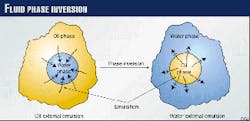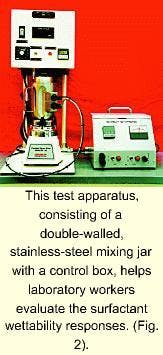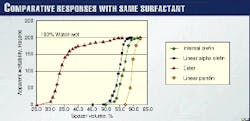A new technique, which makes use of a fluid's capacity to conduct electricity, shows great promise in evaluating the apparent wettability of spacer and preflush fluids.
Laboratory evaluation of these fluids, which precondition surfaces before conducting cement operations, has helped reduce surfactant costs by as much as 50% while minimizing costly zonal isolation problems.
This first of a two-part series describes new test procedures and equipment for testing apparent wettability and provides additional theoretical background for describing oil and water-wet phase behavior.
The conclusion describes use of this new technology in a field setting operated by Chevron Inc.
Background
Because cement cannot adhere to oil-wet surfaces left by nonaqueous drilling fluids, a spacer fluid, formulated with surfactants used to convert oil-wet into water-wet surfaces, provides the necessary component for displacing drilling fluids within the wellbore.
If the spacer fluid is correctly formulated, all surfaces become completely water-wet ahead of the cement procedure. Thus, the spacer must be designed to reduce cement contamination, alleviate bonding problems, and help ensure a strong annular seal.
The apparent wettability methodology can provide a basis for comparing various spacer-surfactant systems used to determine which surfactants are most effective in achieving water-wettability for a given well. Using this information, laboratory personnel can custom design spacer formulas for optimal performance and efficiency.
Evaluating wettability
While engineers and operators have long known the importance of achieving 100% water-wettability prior to cementation, no means for definitively evaluating the wettability phase have yet been made available.
As follows, the conventional method for determining water-wettability, based solely on visual observation, shows the highly subjective nature of this test:
- Dip a glass or metal rod into the drilling fluid and run water over it to determine how easily the fluid slips from the rod. Note whether the fluid leaves a film.
- Dip the clean rod into the drilling fluid again, wash it in the spacer solution, and wash it with a gentle stream of water. If a fluid or oil film remain on the rod, the surfactant package is not sufficiently water-wet under current test conditions.
Several deficiencies have been noted with the use of this method. First, because the test results are based on subjective evaluation, standardization and quality control is not possible. Second, multiple tests performed with the same drilling fluid and spacer may be interpreted differently. Third, variations in the temperature, hardness, amount, and force of the water can affect the results.
Fourth, the surface test of pure spacer and pure drilling fluid do not accurately represent downhole conditions. Therefore, the results obtained with this test may be exaggerated as compared to actual field results.
Finally, because the tests are evaluated on a pass-or-fail system, no data are available for quantifying adjustments in surfactant concentrations. When a test indicates a lack of wettability, surfactants are added, based on the local laboratory's knowledge and experience with specific drilling fluids and surfactants, until the results are satisfactory.
This method frequently increases material costs, and in many cases, yields less than optimal results.
Apparent wettability
To help remove the subjectivity from the evaluation process so that apparent wettability tests can be comparatively repeated at any laboratory, developers designed an "apparent wettability" device.
The principle behind this apparatus is simple: oil-external drilling fluids do not conduct electricity; water-based spacers do. While the apparatus cannot directly measure wettability, it does measure implications of wettability by measuring the electrical activity in the test fluid during the water-wetting process.
The apparent wettability is displayed on a meter in dimensionless units called Hogans (Hn).
Mechanics
How an emulsion transitions from an oil-wet to a water-wet phase provides important information on understanding wettability technology. An oil-wet emulsion, often described as an oil-external, water-internal emulsion, is characterized by oil that surrounds and contains smaller water droplets (Fig. 1).1
This kind of emulsion has the capacity to absorb large amounts of water, which is one reason an oil-external emulsion produces an effective drilling fluid. Synthetic, mineral, and oil-based drilling fluids provide examples of an oil-external emulsion.
When an oil-external emulsion contacts an aqueous fluid, the emulsion will absorb water internally until the external oil layer can no longer contain the enlarged water drop. At this point, the emulsion breaks.
If the aqueous fluid contains no surfactants or contains inappropriate types or concentrations of surfactants, the break in the emulsion can result in a separation of phases, a settling of solids, or a spike in viscosity-all of which can produce hazardous downhole conditions.
When appropriate surfactants are included in the aqueous spacer fluid, however, the emulsion breaks in a controlled fashion. This formulation can then work to prevent separation and settling while allowing a true fluid inversion (Fig. 1).
In this process, the oil-external droplets turn inside out, becoming water-external, oil-internal droplets. Anyone who has used soap to wash away grease has witnessed this oil-external to oil-internal transition firsthand.
The laboratory test apparatus consists of a double-walled, stainless-steel mixing jar with a control box that contains the temperature controller and wettability electronics (Fig. 2). A harness connection provides power to the heater, thermocouple, and electrodes. The device can be used on any laboratory mixer base.
The atmospheric test apparatus enables laboratory chemists to safely test drilling fluid and spacer mixtures at controlled temperatures up to 190° F., under controlled shear rates.
When a stable, oil-external drilling fluid is placed in the mixing jar and sheared, the meter reads 0 Hn. After a sufficient volume of water-based spacer is added, however, and the fluid mixture begins to exhibit electrical activity, the meter can then provide a reliable measurement of the state of emulsion, or apparent wettability.
A meter reading that reaches or surpasses the calibration setting for 100% spacer, and remains unchanged regardless of shear rate, indicates that the fluid has achieved 100% water-wettability.
Fig. 3 shows the intermixing zone created when an aqueous spacer is used to displace the oil-based drilling fluid. The apparent wettability measurement specifically examines the portion of the zone where the fluid phase inverts from oil to water-wet.
Explaining phase evolution
Kinetically, the Winsor microemulsion model can explain phase evolution and fluid behavior for an oil-external to water-external macroemulsion (Fig. 4).
These thermodynamically unstable macoremulsions, temporarily stabilized by some form of agitation, contain dispersed phases that are relatively large in volume.2 3
Typically, droplets within the microemulsions are larger than 500 nm. As follows, the Winsor model includes three types:
- Winsor Type I. As the water-based properties begin to dominate the microemulsion, the fluid enters the Winsor Type I phase. At this point, 100% water-wettability is attained. In this phase, macroemulsions also require minimal shear for maintained stability.
- Winsor Type II. The oil-external microemulsion droplets that exist in this phase help to create stable, oil-external macroemulsions that require a minimal shear for maintained stability. An oil-based drilling fluid is an example of a kinetically stabilized macroemulsion.
- Winsor Type III. The microemulsion in this phase may be bi-continuous-neither water-external nor oil-external. Macroemulsions in this region are not stable; instead they require shear for maintenance.
Electrical conductivity of these macroemulsions may emulate the conductivity of a water-external or an oil-external fluid, depending on the progression of the inversion. If the emulsion droplets are more characteristic of an oil-external fluid, electrical conductivity will be relatively low; however, if the droplets are more similar to a water-external fluid, conductivity readings will be relatively high.
In laboratory testing, the addition of aqueous spacer to a synthetic or oil-based drilling fluid initially produces a low level of electrical conductivity in the Winsor Type III region. With the addition of more spacer fluid, this conductivity increases to a maximum level as the macroemulsion reaches a water-wet state.
When a change in the shear rate results in an increase or decrease in the conductivity measurement, the macroemulsion remains in the Winsor Type III region.
The Winsor model explains why drilling and spacer fluids appear to have inverted into a water-external emulsion, reverting to an apparent oil-wet state as shearing stops. Conversely, this model also explains why a fluid, which does not appear to be water-wet at some shear level, may appear to be fully water-wet under static conditions.
Furthermore, the Winsor model may explain the variability often observed between tests performed with the traditional rod-dipping test, a procedure which does not involve shearing during the rinsing process.
In this case, a lack of stable electrical conductivity indicates that the fluid system is still in the Winsor Type III phase and has not yet become fully water-wet.
The surfactant balance
Defining a surfactant's effect on wettability forms one of the most important functions of the apparent wettability test apparatus. Drilling fluids are not all created equal; neither are surfactants. For example, Fig. 5 shows how one surfactant package can produce various water-wetting responses when used with different drilling fluids.
A delicate balance exists among surfactants for each well application, and many surfactants have the capacity to provide some degree of water-wetting. This capacity, however, may vary when surfactants are blended or subjected to varying temperatures.
Some surfactants can act as emulsifiers, competing with the primary water-wetting agents. Determining which surfactants are the most effective water-wetters, then determining the correct concentrations for displacing a given drilling fluid, provide the key elements for designing a spacer-surfactant formulation that is both effective and economical.
Wettability procedure
Just before the apparent wettability test, laboratory workers recommend the following three preparations for simulating well conditions:
- Shear the drilling fluid sample for at least 30 min. This ensures that the drilling fluid remains homogenous, the solids become suspended, and that the emulsifiers function properly.
- Prepare 500 cc of each spacer and preflush fluid to be tested, using the mixing procedures recommended for each fluid.
- To stabilize the fluids and ensure that all chemicals are in solution, precondition the drilling fluid along with all spacer fluids at the anticipated bottom-hole circulating temperature. For safety purposes, maintain temperatures below 190° F.
To determine the effects of various surfactants on a drilling fluid with unknown wettability requirements, the following nine-step test is typically performed:
- Fill the blender cup with water and preheat the cup to the required temperature. This test temperature should remain constant throughout the test.
- Quickly empty the water from the cup and place enough preconditioned spacer in the cup to cover the electrodes. Stir at 300 rpm.
- Set the meter at the maximum reading that will be targeted during the test (calibration setting).
- Turn off the heat to the cup, remove the spacer fluid, clean the cup, and return it to the mixer base. The meter should read zero.
- Pour 200 cc of preconditioned drilling fluid into the cup and shear at low speed. The meter should remain at zero.
- Add an equal volume of spacer fluid to the cup to achieve a 50:50 drilling fluid-to-spacer ratio while stirring.
- As the mixture becomes homogenous, add surfactants one at a time and observe the meter reading. When the meter reaches the calibrated setting, the mixture becomes fully water-external as the drilling fluid inverts.
- If a flat-line or decrease in the meter reading occurs at some level below the calibrated setting, add more spacer and continue to monitor.
- Monitor the maximum reading for 10 min at low and high shear rates to confirm reliability. A reliable reading will remain stable during this period. If the reading falls, adjust the surfactants until the reading is stable.
Test results
A meter reading that meets or exceeds the calibrated setting on the test apparatus, while remaining stable at varying shear rates, indicates that the fluid has inverted and is 100% water-wet.
A lack of water in the solution may cause the meter to flat-line or decrease (Step 7) before it reaches the calibrated setting. Under these conditions, which prevail among drilling fluids with high oil-water ratios, the surfactant's water-wetting capacity is reduced.
The addition of the water can free the molecules, generating an increase in the apparent water-wettability reading on the test meter. The 50:50 drilling fluid-spacer ratio begins a starting point for designing a formulation that is both effective and economical.
Adjustments in this ratio may be necessary for obtaining 100% water-wettability in some applications. For example, some drilling fluids, particularly synthetic fluids with a low yield point, may release solids into the well when the phase change occurs.
In other cases, the fluid-inversion point may coincide with a counterproductive spike in viscosity. Adjusting the ratio so that the fluid inverts at a ratio other than 50:50 can often eliminate these problems.
References
- Patel, A., Wilson, J.M., and Longbridges, B.W., "Impact of Synthetic-Based Drilling Fluids on Oilwell Cementing Operations," SPE paper 50726 presented at the International Symposium on Oilfield Chemistry, Houston, Feb. 16-19, 1999.
- Winsor, P.A., "Hydrotropy, Solubilisation, and Related Emulsification Processes," Transactions of the Faraday Society , Vol. 44, 1948, p. 376.
- Graciaa, A., LaChaise, J., Marion, G., and Schechter, R.S., "A Hydrophile-Lipophile Balance for Emulsification," Langmuir, Vol. 5, 1989, p. 1315.
The Authors
James Heathman is a technical analyst for Halliburton's Houston business development area, specializing in cementing and conformance technology. He has held a variety of engineering assignments since joining Halliburton in 1987. Heathman holds a BS and MS in petroleum engineering from Louisiana Tech University and an MBA from Oklahoma State University.
J. Michael Wilson is a technology scientific advisor in the zonal isolation group of Halliburton Energy Services Inc.'s Duncan Technology Center and is the technical liaison to Baroid Drilling Fluids. During his 23 years with Halliburton, he has served as a group leader in analytical research and as technical manager for various departments including zonal isolation and water and sand-control.
Wilson holds a doctoral degree in organic chemistry in addition to masters and bachelors degrees in chemistry, all from the University of Oklahoma.
James H. Cantrell is a principal electronics technician responsible for the design and development of zonal isolation testing equipment. During his 23 years of service with Halliburton Energy Services Inc., he has designed and developed hydraulic fracturing and cementing equipment. Cantrell holds an associates degree in electromechanical technology from Murray State College.







